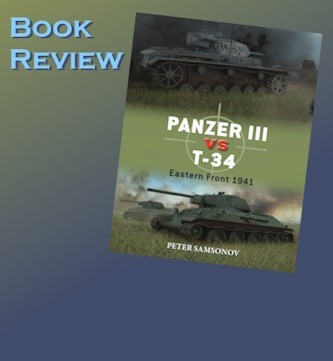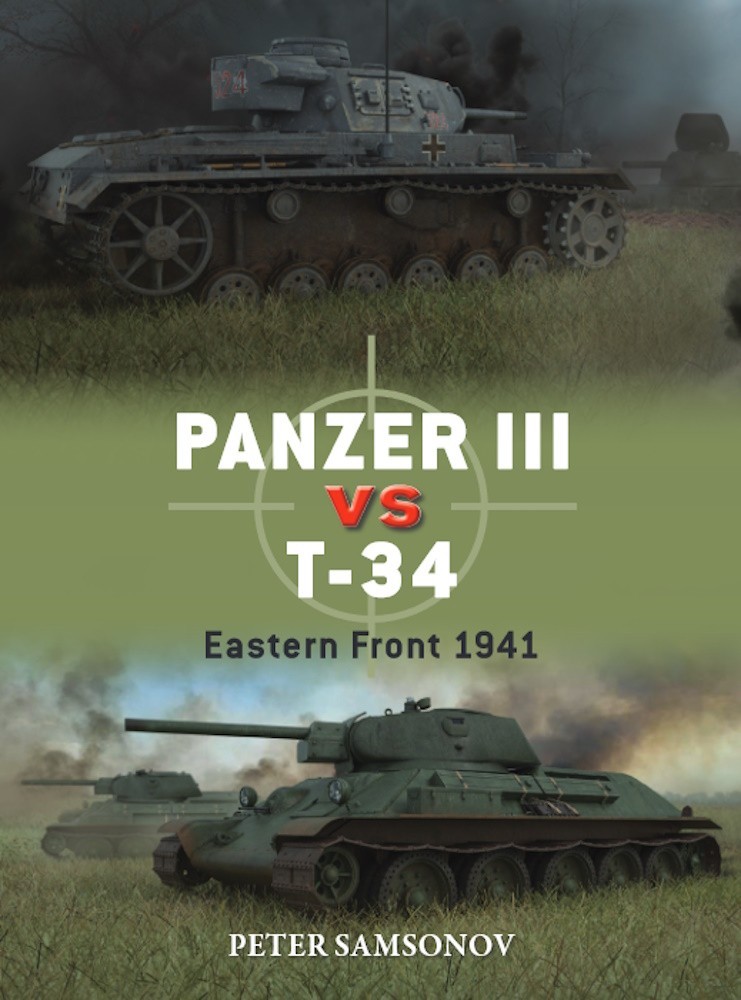
Introduction
When Hitler ordered the execution of Operation Barbarossa in 1941, both Germany and Russia fielded several tank types. The tanks closest to today's MBT (Main Battle Tank) were Germany's Panzerkampfwagen III (PzKpfw III, or Pzr III) and the Soviet Union's T-34. While the Pzr III was evolutionary, the legendary T-34 was revolutionary. This book recounts the story of those two tanks, comparing and contrasting their performance against one another, and other tanks.
Panzer III vs T-34 Eastern Front 1941 is a recent release from Osprey Publishing. Authored by Peter Samsonov it is the 136th title in the series Duel. This 10"x7" softcover book is 80 pages in length, and catalogued with Osprey's short code DUE 136 and ISBN 9781472860934. It is also available in PDF and ePUB formats. Osprey describes this book thus;
This book evaluates the PzKpfw III and T-34 medium tanks fielded by Germany and the Soviet Union during 1941. Both designs were intended to be the primary medium tanks of their respective armies, but owing to manufacturing difficulties, neither was available in quite the numbers intended. Even though both tanks were relatively new, neither was deemed entirely satisfactory, and replacements for both were already on the drawing board. Nevertheless, it was these tanks that clashed in what the Soviet Union called the Great Patriotic War.
While the T-34 rapidly established a fearsome reputation only sometimes borne out by its actual performance, the PzKpfw lII was smaller, lighter, and not as well armed as its Soviet opponent but benefited from the support of a more seasoned and better structured army. Full-colour artwork, archive photographs and authoritative text drawing upon Russian- and German-language sources combine to reveal how the Germans harnessed the advantages of combat experience and superior organization to counter the T-34's tactical strengths, but also how the PzKpfw III quickly lost relevance as it became evident that it could not carry a gun powerful enough to destroy the T-34 at range.
Pzr IIIs and T-34s are popular subjects for modelers. Now lets see what this book has for us.
Contents
Panzer III vs T-34 continues in the Duel series standard format of 80 pages and the following chapters:

I think this book is well organized and written. It contains a lot of technical detail concerning Pzr III and T-34. It also includes descriptions of tables of organization and equipment of various formations for both sides. In addition, it addresses how the Red Army, with some 20,000 tanks when the Germans invaded, was stomped into the ground due to systemic Soviet supply and training failures.
A glossary of German and Soviet terminology is provided, oddly at the end of the book. Two tankers are profiled with two-page biographies, German Ludwig Bauer and Russian Dmitry F. Lavrinenko. Excerpts from reports and journals enrich the text such as a report by Major-General Rodion N. Morgunov's view of the opening days of Barbarossa:
Frequent and rushed changes in location ordered by superior staffs (70–80km away from the previous location in the span of one day) led to the units not being able to gather at the specified location and had to enter battle piecemeal. [...] A number of corps had to conduct 500km-long super-expedited marches in 3–4 days without keeping to elementary maintenance procedures and rest periods prescribed in manuals. As a result, 40–50% of the vehicles were out of action for technical reasons and the remaining materiel was not in a battle-ready condition.
Another report describes the encounters of as yet unknown T-34s and Kv-1s to Guderian:
...the absolute superiority of Russian 26-and 52-tonne tanks over our PzKpfw III and IV was felt. Russian tanks usually line up in a semicircle and open fire at our tanks at a distance of 1,000m using their 7.62cm guns that combine incredible penetration and high precision.
With a concise overview of pre-war Russian and German development of armor and their gaining of experience, Introduction sets the stage for the following chapters. Design and Development presents the background that lead to these tanks. Each receives a survey of initial designs, modifications, improvements and missteps, numbers produced and significant dates. If you are a trivia geek like me, you will appreciate discussing design designations, e.g., the T-34 started as the BT-20 and then re-designated the A-20, and the clandestine codename of what became the Pzr III, the Z.W. (Zugführerwagen or ‘platoon commander’s vehicle’); as new Z.W.s were produced, they received official designations,i.e., the Z.W.3 became the PzKpfw III Ausf. B (2./Z.W.Serie). The text details performance and changes such as the suspension and running gear, engine, guns, observation ports, armor, and a host of other components, plus details, i.e., the Maybach HL120 TRM engine had impulse magneto ignition. We learn of up-armoring with appliqué armor, then solid plates, and mention of armor quality, and weight increases that came with such modifications. We learn of NKOP (People’s Commissariat of Defence Industry) order #335ss which set in motion what became the T-34. Testing regiments are mentioned as well. We learn of the A-34 - development predecessor of the T-34. Technical Specifications follows along with the same depth of history and detail and is split into sub-chapters: Layout (of vehicle); Firepower and Armor; Mobility; Vision and Communications. Some of the information is fascinating, such as Soviet tests of shooting holes in Pzr IIIs from various ranges, and the effect on the armor (did it crack or shatter?) and the size the holes. We also learn of mobility tests and the ability of the designs to overcome obstacles. German and Allied analysis of the T-34's gun and sight is as surprising as it is fascinating.
The Combatants examine the armor organization and crew training for the Russians and Germans. Details within include the composition of tanks and support vehicles, ammunition and spares availability, training hours allocated for Red Army and Wehrmacht tankmen, education of the populous, and military service deferrals. Again, we are introduced to translations and trivia such as vollwertiger Kämpfer (‘fully capable fighter’, and OSOAviaKhim (Society of Cooperation with Defence, Aircraft and Chemical Construction). In comparing and contrasting German and Red Army AFVs, the author offers some interesting match-ups beyond T-34s and Pzr IIIs, such as the SdKfz 251 and SdKfz 222 verses T-26s. Strategic Situation recounts how many AFVs and other vehicles, plus ordnance, each side was allocated compared to what they actually fielded at the beginning of Barbarossa.
Combat begins with the opening hours of Barbarossa and continues through the end of Operation Typhoon. There are a few accounts of small unit fighting such as when a T-34 held off over 30 of Panzer-Regiment 25's PzKpfw 38(t) tanks. But if you are looking for pages of examples of T-34s and Pzr IIIs slogging it out in fire, sparks and smoke, this is not the book for you. The majority of the chapter is a macro perspective of the T-34's impact on Barbarossa, and its influence on the Panzer Commission, which inspected captured weapons.
Statistics and Analysis and Aftermath discuss the losses and recovery of tanks, tactics, and change in battle doctrines, as well as what influences and modifications German tanks and T-34s had upon the other.
I learned things from the text that increase my interest in the subjects. Now for the visual part of this book.
Photographs, Artwork, Graphics
Modelers can find a wealth of reference for their modeling. Typical of Osprey books, the visual aspect of this book is strong. Most pages have at least one photo or image. Reproductions of wartime manuals and intelligence reports are included. Several color photos show museum tanks and artifacts, with one from the war. Color images include a T-34's V-2 engine, tracks, cutaway of T-34 hull, crew compartment, and several Pzr IIIs in museums.
A few photos that are particularly interesting:
1. An A-34 aflame during Molotov cocktail tests.
2. A T-34 immobilized after ramming a PzKpfw II.
3. PzKpfw III crew attempting to extract their tank from a frozen bog or pond with a Izbas in the background.
4. Massacred Pzr III and SdKfz 250s at Smolensk.
5. Pzr III fording river past boats and debris.
Artwork
1. PzKpfw III Ausf. E: color illustrations of each end; profile; planform.
2. PzKpfw III Ausf. J: color illustrations of each end; profile; planform.
3. Early-Production T-34: color illustrations of each end; profile; planform.
4. Late-Production T-34: color illustrations of each end; profile; planform.
5. Two vision diagrams of visibility angles for the T-34 and Pzr III.
6. 5cm KwK 38 L/42 keyed to 11 components.
7. 76mm F-34 keyed to 11 components.
8. Map: German and Soviet formations equipped with either the PzKpfw III or the T-34 on the eve of Operation Barbarossa.
9. Two-page battlescene of a T-34 ramming a PzKpfw III.
10. Map: fighting for Mtsensk, 3–11 October 1941.
11. PzKpfw III gunsight view.
12. T-34 gunsight view.
13. Fragment of a German instruction manual on fighting the T-34.
14. Translation of a Soviet pamphlet detailing the weaknesses of the PzKpfw III.
For my money, I found several images that inspire me to model more Pzr IIIs and T-34s.
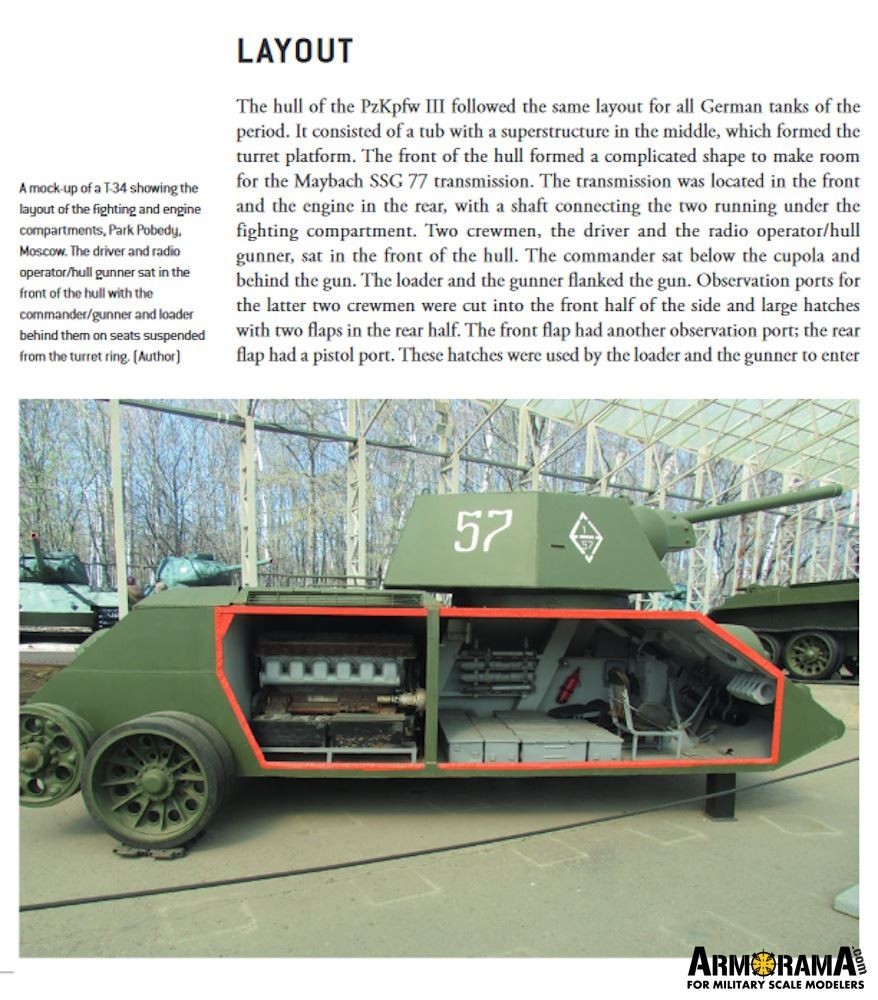
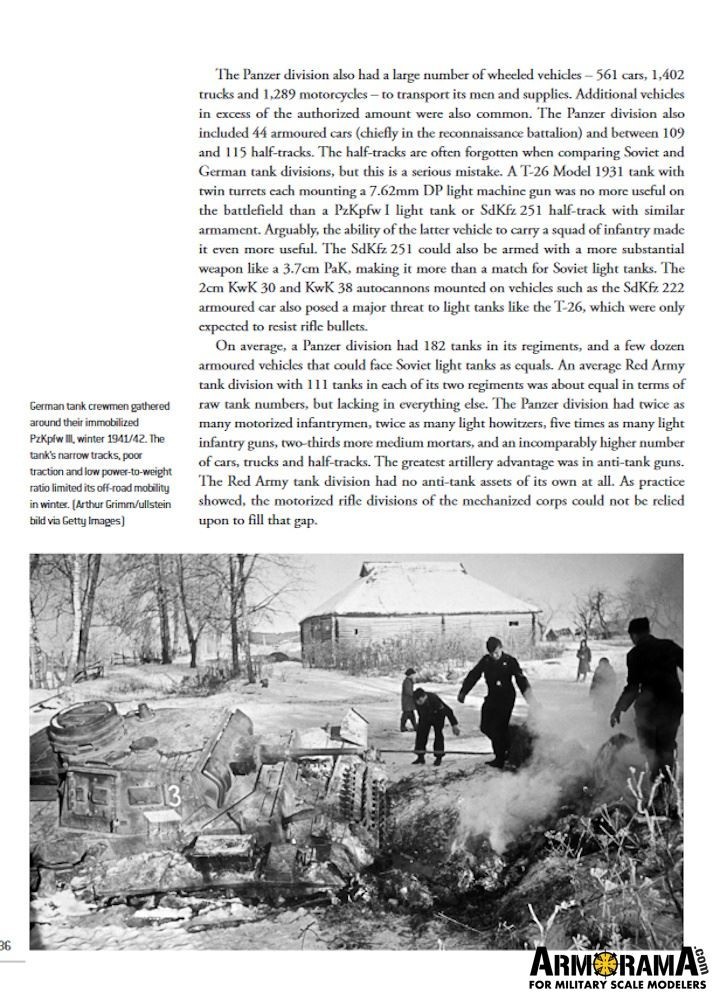

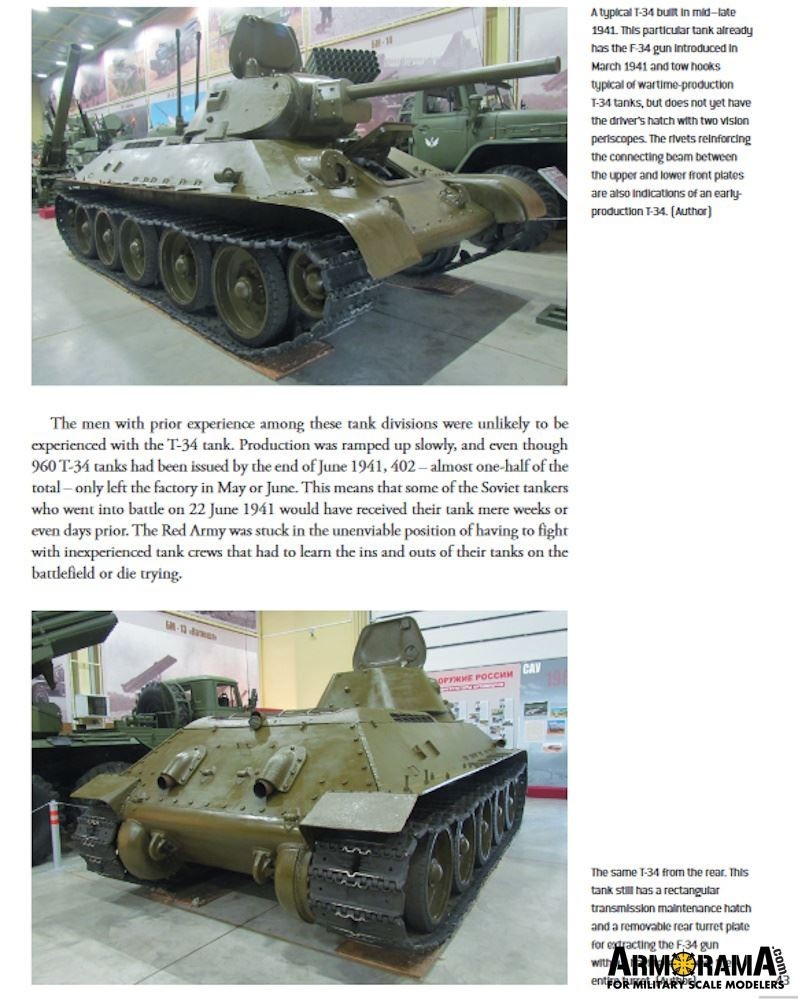
Concludion
Although volumes have been written about these subjects, Osprey's Panzer III vs T-34 is a good primer about these two adversaries and their role in the armored war of Barbarossa, and later. It is a good start for modelers and history fans of these tanks, and sows the seeds for further research. The technical information is interesting, as is the operational content that helps explains the early German successes, and Soviet recovery. I found several photos that inspire an interest to model T-34s and Panzer IIIs, as individual tanks and for dioramas.
Thus, I think this book is worth a space on the modeling shelf. Recommended.
Please remember to mention to Osprey and retailers that you saw this product here -on Armorama.










